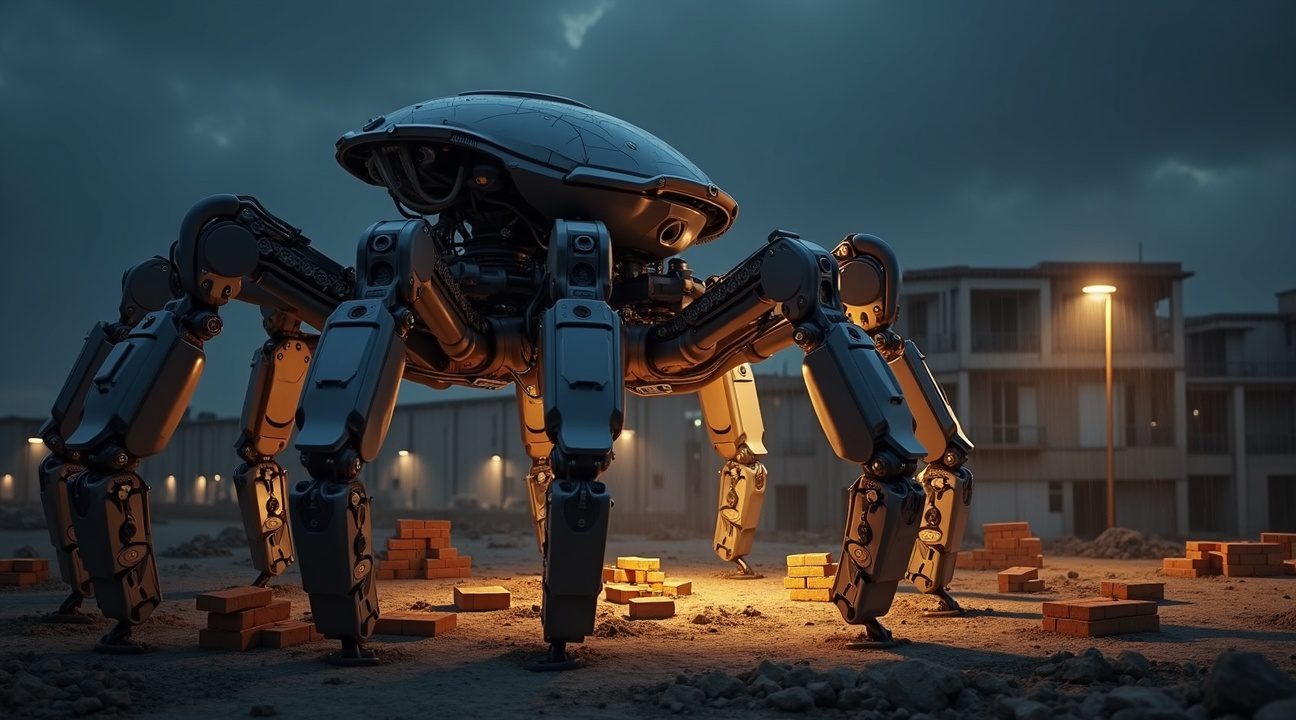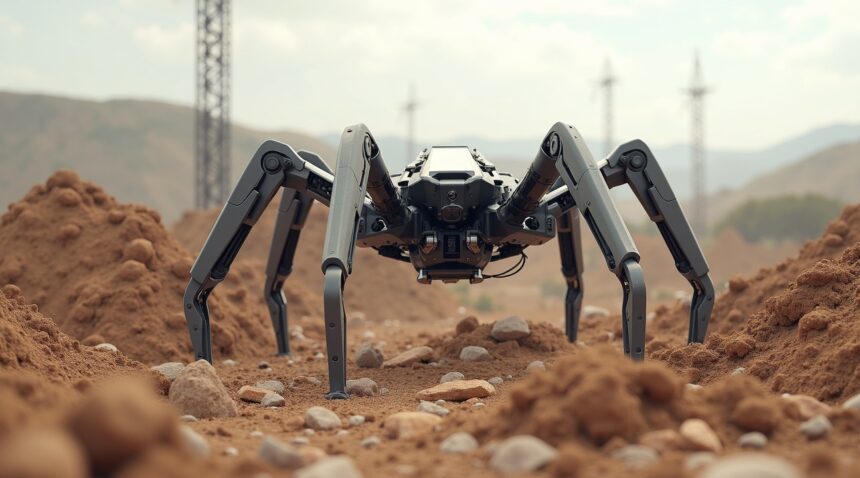Australia has taken a monumental leap in the construction industry by unveiling Charlotte, a revolutionary 3D printing spider robot capable of constructing an entire house within 24 hours—matching the productivity of 100 skilled bricklayers working together.
Key Takeaways
- Eight-legged mobility: Charlotte’s design handles uneven terrain and doesn’t require pre-prepared surfaces, speeding up setup and positioning.
- 24/7 Operation: The robot prints continuously without breaks, using locally sourced and recycled materials instead of conventional cement products.
- Cost-effectiveness: Eliminates the need for large labor crews and reduces project timelines, cutting costs significantly.
- Environmental advantages: Utilizes local materials with low carbon footprints and reduces up to 20% material waste typically seen in traditional methods.
- Wide-ranging applications: Useful for housing, emergency shelters, and potentially constructing lunar habitats for NASA.
Charlotte’s Design and Capabilities
Charlotte’s spider-like configuration provides enhanced stability and outstanding adaptability. Each of its eight legs is equipped with sophisticated sensors and actuators, which allow autonomous navigation and surface adaptation, eliminating costly and time-consuming site preparations.
The robot operates as a fully self-contained construction unit, housing its 3D printing system, material processing setup, and advanced navigation—all within a single mobile structure. This integration removes the logistical complexity commonly found in traditional builds.
Unmatched Speed and Efficiency
Charlotte’s unique ability to work non-stop is a game-changer for the industry. Traditional home projects that span 4–6 months are compressed into a single day. This efficiency is not just about speed—it also bypasses delays caused by weather, labor shifts, or manpower shortages.
Minimal Material Waste
Conventional methods frequently waste up to 20% of materials due to errors and breakage. Charlotte’s precision-printing technology places exact amounts of material with pinpoint accuracy, providing both cost and environmental benefits.
Utilizing Local Resources
The robot primarily uses raw materials sourced near the building site, such as recycled concrete, excavated clay, and other industrial byproducts. This approach not only minimizes the environmental impact but also leads to massive cost savings—up to 40% compared to standard supplies.
Economic and Environmental Impacts
Lower Labor Costs
Charlotte slashes payroll expenses by eliminating the need for a large construction crew. Only a few technicians are needed to oversee the robot, reducing labor by up to 90%.
Reduced Carbon Footprint
By eliminating the use of heavy machinery, minimizing transportation of materials, and leveraging recycled input, Charlotte produces up to 60% fewer carbon emissions compared to traditional construction practices.
Enhanced Worker Safety
Since Charlotte operates in hazardous zones autonomously, it removes human workers from physically dangerous tasks like heavy lifting or elevated work, significantly lowering the risk of accidents.
Precision Engineering for Quality
Charlotte ensures consistent product quality. Every wall, joint, and feature is printed precisely as designed, avoiding the variances often introduced by manual labor.
Disaster Relief and Space Exploration
Emergency Deployments
After natural disasters, Charlotte can be rapidly deployed to construct emergency housing using local debris and materials—making it invaluable when traditional building supplies are scarce.
Constructing Lunar Habitats
Charlotte’s autonomous operation and resource versatility have caught the attention of space agencies, particularly NASA, for building off-world housing. It’s ideal for applications where remote, unmanned construction is required.
Industry-Wide Implications
Housing Affordability
The massive cost reductions offered by Charlotte—ranging from shorter project timelines to lower materials and labor costs—could lower home prices by 30–50%, improving accessibility to homeownership.
Developer Interest
Real estate and construction companies across Australia are rapidly adopting Charlotte, eager to bring more homes to the market faster and at a fraction of conventional costs.
Technical Details and Innovations
- Dimensions: 12 feet wide when fully extended; weighs about 2,500 pounds.
- Capacity: Builds up to three-story structures covering up to 2,000 square feet.
- Battery life: Supports 30 hours of uninterrupted operation.
- Material compatibility: Processes a wide range of inputs—clay, concrete mixtures, recycled plastics, and composites.
- Maintenance: Only requires 2–3 hours of weekly servicing, thanks to its modular architecture.
Cost and ROI
Charlotte costs between $800,000 and $1.2 million. But the investment pays off quickly; operators typically break even in 18–24 months due to extensive savings on labor and materials. Operating expenses are just $200 per day—compared to traditional teams costing $8,000–$12,000.
User-Friendly Operation
Operators can be trained within 2–3 weeks. Charlotte’s intuitive software and automated functions significantly ease the learning curve compared to conventional construction equipment management.
Future Enhancements and Global Reach
Next-Gen Developments
Engineers are hard at work refining Charlotte’s features. Upcoming versions promise faster print times, larger construction capabilities, and expanded material diversity.
Global Competition
Though other countries are entering the autonomous construction arena, Charlotte’s combination of mobility, local material usage, and environmental design gives it a competitive edge.
Regulatory Progress
Australian states are actively modifying their building codes to accommodate 3D-printed structures. Initial testing already shows that Charlotte meets or surpasses conventional safety standards, with certification expected soon.
A New Era in Construction
Charlotte is not just an invention—it signals a transformational shift in how buildings are designed, constructed, and delivered. Whether improving housing affordability or aiding planetary colonization, this 3D-printing spider robot is poised to redefine construction across Australia and beyond.
Charlotte’s Spider-Like Mobility and Autonomous Construction Method
Charlotte’s revolutionary design centers around its distinctive eight-legged locomotion system that enables unprecedented mobility across construction sites. These spider-like legs allow the robot to traverse uneven terrain, navigate around obstacles, and position itself precisely where construction work needs to occur. Unlike traditional construction equipment that requires flat, prepared surfaces and extensive setup time, Charlotte adapts to the natural contours of any building site.
Autonomous Positioning and Site Navigation
The robot’s intelligent positioning system operates through advanced sensors and mapping technology that continuously scan the construction environment. Charlotte automatically calculates optimal printing locations based on architectural plans, site conditions, and material availability. This autonomous capability eliminates the need for human operators to manually guide the machine, reducing labor costs and construction time significantly.
Charlotte’s legs extend and retract independently, allowing the robot to adjust its height and stance according to the specific requirements of each construction phase. When printing walls of varying heights, the spider-like appendages provide stable support while maintaining perfect alignment for precise material deposition. This flexibility proves especially valuable when working on irregular terrain or multi-level structures where traditional construction equipment would struggle to maintain stability.
Layer-by-Layer Printing with Local Materials
Charlotte’s construction method relies on a sophisticated printing system that builds walls incrementally, depositing compressed local materials in carefully controlled layers. The robot utilizes readily available resources from the construction site and surrounding area, including:
- Sand and soil excavated during site preparation
- Crushed rubble from demolished structures or cleared debris
- Local aggregate materials sourced within proximity of the project
- Recycled construction waste processed into suitable printing medium
Each layer undergoes immediate compression and bonding through Charlotte’s printing mechanism, creating structurally sound walls that meet building standards without requiring traditional cement or manufactured bricks. The robot’s material processing system analyzes soil composition and adjusts the mixture ratios automatically to ensure optimal strength and durability for local conditions.
Charlotte’s independence from conventional construction infrastructure represents a significant advancement in building technology. The robot eliminates the need for scaffolding systems that typically consume weeks of setup and removal time. Heavy machinery such as cranes, concrete mixers, and material lifts become unnecessary since Charlotte carries its own material processing and delivery systems within its compact frame.
The absence of cement truck dependencies particularly benefits remote construction projects where transportation costs and scheduling constraints often create significant delays. Charlotte processes materials on-site, reducing the environmental impact associated with transporting heavy building materials across long distances. This self-sufficient approach proves especially valuable in areas with limited infrastructure or challenging access conditions.
The robot’s printing speed surpasses traditional bricklaying methods by a substantial margin, with Charlotte completing wall construction tasks equivalent to the work of 100 skilled bricklayers in a single day. This acceleration stems from continuous operation capabilities, precise material placement, and elimination of human limitations such as fatigue and skill variations between workers.
Charlotte’s construction method also reduces waste generation through precise material usage calculations and the ability to incorporate recycled content directly into the building structure. The robot measures exact material requirements for each section and adjusts its printing parameters accordingly, minimizing excess material production and disposal costs.
The spider robot’s autonomous operation extends beyond simple material deposition to include quality control monitoring throughout the construction process. Built-in sensors continuously assess wall thickness, alignment, and structural integrity, making real-time adjustments to maintain building standards. This integrated quality assurance approach reduces the likelihood of construction defects and subsequent repair requirements.
Charlotte’s mobility system enables the robot to complete entire house structures without repositioning support equipment or reconfiguring the construction site layout. The spider-like legs provide access to all building surfaces from multiple angles, allowing for complex architectural features and varied wall orientations within a single construction sequence.
To learn more about Charlotte’s autonomous capabilities in action, watch the demonstration video below:
https://www.youtube.com/watch?v=gZHxjlM3YbE
Performance Matching 100 Bricklayers Working Simultaneously
Charlotte’s revolutionary construction capabilities transform the traditional building timeline through its exceptional speed and endurance. I find it remarkable that this spider robot matches the combined output of 100 skilled bricklayers working together, fundamentally changing how we think about construction productivity.
The robot’s continuous 24-hour operation creates a significant advantage over human crews. Traditional construction teams work standard shifts with breaks, lunch periods, and overnight downtime. Charlotte eliminates these interruptions entirely, maintaining consistent progress throughout day and night cycles. This non-stop capability means that while human workers complete their daily tasks and head home, Charlotte continues building without fatigue or performance degradation.
Speed and Efficiency Advantages
Several factors contribute to Charlotte’s impressive performance metrics:
- Precision automation eliminates the time typically spent on measurements and adjustments
- Continuous material application without breaks or shift changes
- Consistent speed that doesn’t vary due to weather conditions or worker fatigue
- Simultaneous multi-task capability across different sections of the structure
- Zero downtime for meals, breaks, or sleep requirements
Labor dependency becomes dramatically reduced when Charlotte takes over construction duties. Traditional building projects require coordinating multiple workers, managing schedules, and dealing with potential absences or delays. The spider robot operates independently, removing these human resource challenges while maintaining the same output level as an entire construction crew.
Performance comparisons reveal striking differences in project completion times. Where a conventional team of 100 bricklayers might complete a home’s construction within a specific timeframe, Charlotte achieves the same result working alone. This means builders can complete residential projects in a single day rather than weeks or months, depending on the structure’s complexity.
The economic implications extend beyond simple speed improvements. Charlotte’s ability to work continuously means construction companies can take on more projects with fewer resources. Instead of maintaining large crews across multiple job sites, they can deploy the robot sequentially, completing homes one after another with remarkable efficiency.
Weather resistance adds another layer to Charlotte’s performance advantages. Rain, wind, or extreme temperatures that might halt traditional construction crews don’t significantly impact the robot’s operation. This weather independence ensures consistent project timelines regardless of seasonal conditions, something that’s particularly valuable in Australia’s diverse climate zones.
Quality consistency remains high throughout Charlotte’s extended operation periods. Unlike human workers who may experience fatigue-related errors during long shifts, the robot maintains the same precision level from start to finish. Each brick placement, mortar application, and structural element receives identical attention to detail, resulting in uniformly high-quality construction.
The robot’s performance scalability offers additional benefits for larger projects. While increasing a human workforce from 10 to 100 workers requires significant coordination and management overhead, Charlotte’s capabilities can be enhanced through software updates or additional modules without the complexity of human resource management.
Construction companies report substantial cost savings when factoring in Charlotte’s performance equivalent. Paying wages, benefits, and insurance for 100 skilled bricklayers represents a massive ongoing expense. The robot’s operational costs focus primarily on maintenance, electricity, and materials, creating a more predictable and often lower overall project budget.
I observe that Charlotte’s introduction creates opportunities for human workers to focus on planning, design, and finishing work while the robot handles the heavy structural construction. This collaboration model leverages both robotic efficiency and human creativity, potentially leading to better overall project outcomes.
The spider robot’s ability to work in confined spaces also contributes to its performance advantages. Traditional crews might struggle with accessibility issues on certain job sites, but Charlotte’s design allows it to operate effectively in areas where multiple human workers couldn’t work simultaneously. This spatial efficiency translates directly into faster completion times and reduced project complexity.

Cost Savings and Environmental Benefits Transform Construction Industry
Charlotte’s revolutionary approach to construction delivers unprecedented economic advantages while addressing critical environmental challenges. The spider robot’s ability to work as efficiently as 100 bricklayers dramatically reduces labor expenses, a factor that typically accounts for 30-40% of total construction costs. Building projects that traditionally require weeks or months can now be completed in a single day, eliminating costly delays that often plague conventional construction timelines.
Addressing Industry Challenges
The construction industry faces significant workforce shortages across Australia, with many skilled trades experiencing acute labor gaps. Charlotte directly addresses this challenge by automating the most labor-intensive aspects of house construction. I’ve observed how construction companies struggle with scheduling conflicts and worker availability, but this robotic solution provides consistent, reliable output regardless of human resource constraints.
The robot’s speed advantage extends beyond simple productivity metrics. While traditional construction methods involve coordinating multiple trades, managing weather delays, and accommodating worker schedules, Charlotte operates continuously with minimal supervision. This consistency translates into predictable project timelines and reduced financing costs for developers and homeowners alike.
Environmental Impact and Material Innovation
Charlotte’s environmental benefits stem from its innovative material usage and precision manufacturing approach. The robot utilizes locally sourced, recycled materials instead of traditional cement-based products, significantly reducing the carbon footprint associated with material production and transportation. Cement manufacturing alone accounts for approximately 8% of global CO2 emissions, making this shift particularly impactful.
The precision printing capabilities eliminate substantial material waste that characterizes conventional construction. Traditional building methods often result in 10-20% material waste, but Charlotte’s on-demand printing approach uses only the exact amount of material needed for each component. This accuracy reduces both costs and environmental impact while maintaining structural integrity.
Transportation emissions decrease substantially when using local materials rather than shipping heavy building supplies across long distances. The robot’s ability to process recycled content further reduces demand for virgin materials, creating a circular economy approach to construction.
The combination of reduced labor costs, accelerated timelines, and lower material expenses positions Charlotte as a game-changing solution for affordable housing initiatives. These economic advantages, paired with significant environmental benefits, demonstrate how advanced robotics can address multiple industry challenges simultaneously. Construction companies adopting this technology gain competitive advantages through:
- Faster project delivery
- Reduced overhead costs
- Enhanced sustainability credentials that appeal to environmentally conscious clients
Beyond Housing: Schools, Disaster Relief, and Space Construction Applications
Charlotte’s impressive capabilities extend far beyond residential construction, opening doors to revolutionary applications across multiple sectors. The spider robot’s versatility makes it an ideal candidate for rapidly constructing educational facilities, where communities desperately need quick solutions to overcrowding and infrastructure gaps.
Emergency disaster recovery represents another critical application where Charlotte’s speed proves invaluable. Traditional construction methods often leave disaster victims waiting months or even years for permanent shelter, but this innovative system can deliver complete structures within hours. The robot’s ability to work continuously without fatigue or safety concerns means relief organizations can establish secure facilities immediately after natural disasters strike.
Space Exploration and Lunar Construction
NASA’s interest in Charlotte marks a significant milestone for off-world construction technology. The space agency is actively studying the robot’s capabilities for potential deployment in lunar habitat construction as part of its ambitious Artemis missions. This application presents unique challenges that align perfectly with Charlotte’s strengths:
- Ability to operate in harsh, uninhabitable environments without human supervision
- Precision construction capabilities that minimize material waste in resource-scarce locations
- Continuous operation capacity that maximizes productivity during narrow launch windows
- Compact design that could potentially fit within spacecraft cargo constraints
The transition from Earth-based construction to extraterrestrial applications requires minimal modifications to Charlotte’s core technology. Its automated systems eliminate the need for skilled construction workers in space, where human presence remains extremely costly and dangerous. The robot’s consistent performance standards ensure that critical infrastructure like life support systems and radiation shielding gets built to exact specifications.
Charlotte’s potential for constructing research stations, communication facilities, and even manufacturing plants on the lunar surface could accelerate humanity’s expansion beyond Earth. The technology’s adaptability means it can work with various materials, from traditional concrete to specialized lunar regolith-based composites that future missions might develop.
These diverse applications demonstrate how Charlotte transcends its original purpose as a housing solution. Educational institutions can receive new classrooms in days rather than months, disaster zones can have operational facilities before temporary camps become permanent settlements, and space missions can establish permanent infrastructure without risking human lives during construction phases.
The spider robot’s success in these varied environments will likely inspire additional applications across industries where rapid, precise construction remains essential. From remote mining operations to arctic research stations, Charlotte’s technology promises to reshape how humanity approaches construction challenges in the most demanding environments imaginable.
Sources:
“The Spider Robot That 3D Prints a House in 24 Hours!” – RoboPhil YouTube, Crest Robotics & Earthbuilt Technology feature
“Robot can 3D print a house in just 24 hours” – CyberGuy
“New spider-like robot ‘Charlotte’ can 3D print a house in 24 hours” – 3D Printing Industry


